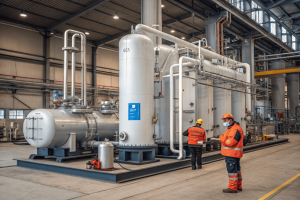What are the unique advantages and major challenges of cryogenic co2 capture?
•
What are the unique advantages and major challenges of cryogenic co2 capture?
You need high-purity CO₂ but traditional methods are complex. Cryogenics seems simpler, but you worry about the extreme cold and high energy costs. This creates a difficult choice.
Cryogenic capture's main advantage is producing high-purity liquid CO₂ directly. Its biggest challenges are the high energy consumption needed for refrigeration and the risk of impurities like water freezing and blocking the system. This makes it a specialized, not a universal, solution.

I've seen clients intrigued by the elegance of cryogenics. It feels like a direct physical separation, which appeals to many engineers. You just get the gas cold enough, and the CO₂ drops out as a liquid or a solid. Simple, right? But the reality of operating at temperatures colder than an arctic winter brings a very specific set of engineering challenges. This technology has a definite place, but it's crucial to understand where it fits and to compare it honestly with other available methods.
Why is membrane separation considered a modular and low-energy option for co2 recovery?
You need a flexible, scalable capture solution. A huge chemical plant is too expensive and complex. You're searching for a simpler, "plug-and-play" option that fits your space and budget.
Membranes are modular because you can simply add more units to scale up. They are low-energy because they use pressure differences, not heat, for separation. This avoids the massive energy penalty of solvent regeneration in traditional systems, making them highly efficient.

Think of membrane technology like building with LEGO bricks. I've designed systems for clients who needed to start small and have the option to expand later. With membranes, we can do that. We install a rack with a certain capacity, and if their needs grow, we just add another rack. This simplicity is a game-changer. There's no massive chemical tower to build. The energy input is mainly for gas compression, not for boiling a solvent, which fundamentally changes the operational cost profile.
Scalability and Simplicity
The core of the technology is a polymer film that is more permeable to CO₂ than to other gases like nitrogen or methane.
Built for Flexibility
The physical setup is a key advantage. Multiple membrane modules are arranged in racks on a metal skid. This offers several benefits:
- Modularity: You can precisely match the capture capacity to the gas flow by adjusting the number of modules.
- Small Footprint: A membrane system takes up much less space than a towering amine absorption plant, making it ideal for retrofitting in tight industrial spaces.
- Simple Operation: It’s a physical process without complex chemical loops, reducing the need for specialized chemical plant operators.
| Feature | Membrane Separation | Amine Absorption |
|---|---|---|
| Scalability | Excellent (modular) | Poor (fixed by column size) |
| Primary Energy | Electricity (compression) | Thermal (steam for regen) |
| Footprint | Small and compact | Very large and tall |
| Operational Simplicity | High (few moving parts) | Low (complex chemical loop) |
Compare the co2 purity levels achievable by PSA, Cryogenic, and Amine Absorption methods.
You need CO₂, but different applications demand different purity levels. Choosing the wrong technology could mean failing to meet product specs or overspending on unnecessary purification.
Cryogenic capture generally achieves the highest purity (>99.9%), producing liquid CO₂ directly suitable for food grade. Amine absorption also reaches high purity (>99.9%) with polishing steps. PSA typically produces lower purity (90-99%), best for industrial, non-food-grade uses.

I often tell my clients to start with their final product in mind. What purity do you actually need? If you are injecting CO₂ for Enhanced Oil Recovery, 95% purity might be perfectly fine. But if you want to sell it to a beverage company, you need to hit that 99.9%+ mark and remove dozens of specific trace contaminants. Each of these technologies can get you there, but they take very different routes, and the costs reflect that. Purity is a specification you pay for.
A Look at the Processes
The final purity is a direct result of the separation mechanism each technology uses.
Cryogenics: The Purity King
This method works by cooling the gas stream until CO₂ turns into a liquid or solid, leaving other gases like nitrogen behind. This phase change is an incredibly effective purification step. It's like distilling a liquid to separate components based on their boiling points. The output is already a high-purity liquid CO₂, which is often the desired final product form anyway.
Amine Absorption: The Versatile Workhorse
Amine solvents are highly selective for CO₂. They do an excellent job of capturing it from the gas stream. The "raw" CO₂ released from the solvent is already quite pure, often around 99%. To reach food-grade levels, this stream is sent through secondary polishing units, like activated carbon filters, to remove trace impurities that came over from the flue gas.
PSA: The Bulk Separator
PSA pushes gas through a solid material that adsorbs CO₂. It is excellent for bulk separation, but it's not perfect. There is always some "slip" where other gases pass through with the CO₂. It is an ideal choice for applications where ultra-high purity is not the primary economic driver.
| Technology | Purity Range | Final Product Form | Common Application |
|---|---|---|---|
| Cryogenic | >99.9% | Liquid | Food & Beverage, Electronics |
| Amine Absorption | 99% - 99.9%+ | Gas (requires liquefaction) | Food & Bev, CCUS, EOR |
| PSA | 90% - 99% | Gas | Hydrogen Production, Gas Sweetening |
In what industrial scenarios is Pressure Swing Adsorption (PSA) the preferred method for co2 separation?
Your process involves a high-pressure gas stream rich in CO₂. A full chemical solvent plant seems like complex overkill. You need a less complicated, more robust system for your specific industrial needs.
PSA is the preferred method for separating CO₂ from high-pressure, relatively high-concentration gas streams. It is ideal for processes like hydrogen production (SMR) or natural gas sweetening, where its mechanical simplicity and lack of liquid solvents make it highly reliable and cost-effective.

I’ve worked on several projects in the hydrogen and natural gas sectors where PSA was the obvious choice. In these industries, the gas you're treating is already at high pressure. We can use that existing pressure to our advantage. The PSA process is beautifully simple in principle: it uses pressure to force CO₂ to stick to a solid material, then releases it by dropping the pressure. There are no hot liquids, no steam reboilers, no corrosion concerns. It’s a robust, mechanical process, which makes it incredibly reliable in tough industrial environments.
The Right Tool for the Job
PSA systems shine in specific niches where their core strengths align perfectly with the process conditions.
Why it Works So Well:
The technology is based on solid adsorbent materials, like a zeolite, that have a strong affinity for CO₂ molecules.
- Adsorption Step: The high-pressure feed gas is passed through a vessel filled with the adsorbent. The CO₂ sticks to the material, while the other gases (like hydrogen or methane) pass through as the product.
- Desorption Step: The vessel is then depressurized. This pressure drop breaks the bond between the CO₂ and the adsorbent, releasing a stream of relatively pure CO₂. The system "swings" between high and low pressure, hence the name.
The ideal conditions for PSA are:
- High Feed Pressure: The process uses the existing pressure, which saves a huge amount of energy on gas compression.
- High CO₂ Concentration: The adsorbent material has a finite capacity, so it works most efficiently when there is a lot of CO₂ in the gas stream to capture.
This is why you'll find PSA as the standard technology for purifying hydrogen in SMR plants and for removing CO₂ from raw natural gas at the wellhead.
Conclusion
Cryogenic capture offers the highest purity but faces energy and freezing challenges. Membranes provide a modular, low-energy alternative. Each technology—PSA, Cryogenic, and Amine—delivers different purity levels for specific industrial needs.
You may also be interested in:

Why is CO₂ recovery technology gaining popularity worldwide?
Why is CO₂ recovery technology gaining popularity worldwide? You see headlines about carbon capture everywhere. But you wonder if it's
Read more
How is a CO₂ recovery system designed to fit different industries?
How is a CO₂ recovery system designed to fit different industries? You're under pressure to implement a CO₂ recovery solution.
Read more
How energy-efficient are today’s CO₂ recovery technologies?
How energy-efficient are today’s CO₂ recovery technologies? You want to recover CO₂, but you fear that high electricity bills will
Read more